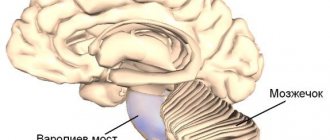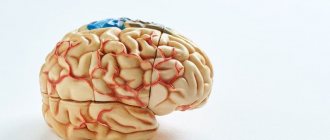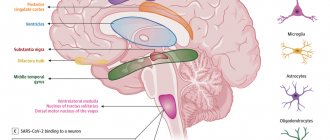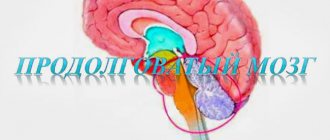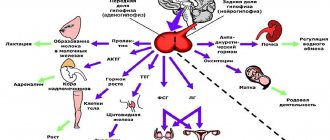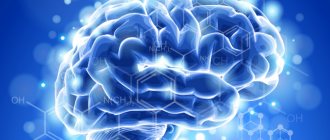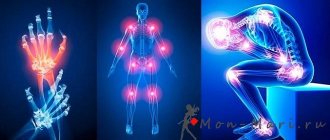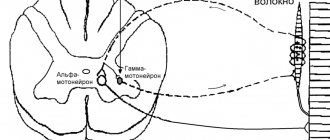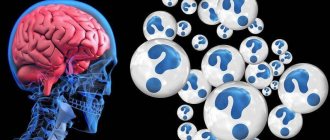The human body works as a whole. The coherence and interaction of all organs is ensured by the central nervous system. It is found in all living beings and consists of nerve cells and their processes.
The central nervous system in vertebrates is represented by the brain and spinal cord, in invertebrates – by a system of unified nerve ganglia. The central nervous system is protected by the bone formations of the skeleton: the skull and spine.
Excitation speed
Any reflex takes place over a certain period of time: some happen faster, others slower. The time that elapses from the beginning of stimulation of the receptors to the beginning of the response is called reflex time. The reflex time consists of the time that is necessary to cause excitation in the receptors and conduct the resulting impulse into the central nervous system, then for the excitation to pass through the central nervous system and to spread along the centrifugal nerves, then for the transition to the working organ and, finally, for the hidden period of excitation of this organ. Thus, the reflex time, as we see, represents the sum of many terms.
Special studies and measurements have shown that the speed of excitation is not the same in different parts of the reflex arc. Excitation passes most slowly through the central nervous system, where excitation is transferred from one neuron to another. Therefore, it is customary to talk about central, or synaptic, delay. Slow conduction in the central nervous system is called delay because it seems as if the excitation, having reached the synapse, encounters some kind of obstacle and is therefore delayed.
Human head brain
This organ is located in the brain section of the skull. Conventionally, it has five sections; inside it there are four cavities that are filled with cerebrospinal fluid. The majority of the organ consists of the hemispheres (80%). The second largest share is occupied by the trunk.
It has the following structural sections:
- average;
- cerebral;
- oblong;
- intermediate.
Transforming the rhythm of excitement
The central nervous system never sends one wave of excitation along centrifugal fibers to the periphery of the working organ; a series of impulses following each other always comes from it. The rhythm of excitation that is sent by the central nervous system is largely independent of the frequency of stimulation that is applied to the receptors. The central nervous system will still respond to any rhythm of stimulation, even the most infrequent one, with a series of impulses. The rhythm of impulses coming from the nerve centers ranges from 50 to 200 per second.
This feature of the central nervous system also explains the fact that all muscle contractions in the body are tetanic. The fastest and most short-term contraction of any muscle is tetanic due to the fact that the muscle always receives a series of successive impulses.
Types of CNS
Oligosynaptic and polysynaptic systems
Essentially important is the presence of two types of ascending systems - oligo- and polysynaptic.
The oligosynaptic system (olygos - small) contains only a few neurons, perceives and transmits information of a specific modality (pain, temperature sensitivity, muscle-articular sense, visual, auditory, etc.) and is projected into small areas - the projection cortex.
The polysynaptic system is a reticular formation of the brain stem, activated by the same specific impulses arriving through collaterals, as well as humoral factors, and projected into the cortex rather diffusely (Fig. 1.1.11). It, in turn, consists of activating and deactivating (synchronizing) subsystems, which have their own biochemical support (mainly norepinephrine and serotonin, respectively). The main function is the regulation of the basic functional state of the brain, primarily the sleep-wake cycle: active and passive wakefulness, fast-wave and slow-wave sleep. Each of the listed states has a special task. Thus, the assimilation of information (purposeful search, comprehension, fixation) is possible only in a state of active wakefulness. Slow-wave sleep, apparently, primarily performs a trophotropic function, while fast-wave sleep has a search function.
Somatic and vegetative (autonomous) systems
An equally important factor is the presence within a single nervous system of two functionally different systems - somatic and autonomic (autonomic). The latter performs a service function, namely: it ensures both the constancy of the internal environment of the body - homeostasis, and changes in the parameters of the internal environment in relation to the tasks performed by the somatic nervous system - homeokinesis.
Summation in excitation in the central nervous system
The next feature of the central nervous system, first discovered by I.M. Sechenov, is its ability to summarize incoming excitations. This feature is
that if a single subthreshold irritation is applied to an afferent fiber, the central nervous system will not respond to such irritation and a reflex reaction will not occur. If several subthreshold stimulations are applied quickly, one after another, the central nervous system will respond with excitement and a corresponding reflex act will occur.
How can we explain that subthreshold impulses, each of which was not able to cause excitation, arriving one after another at a fast pace, cause excitation? This phenomenon is explained by the properties of the nerve center, where each incoming excitation causes a number of changes, in particular, it increases the excitability of the nerve center.
Subsequent irritations, if they are quite frequent, fall into a period of increased excitability and, when added up, become sufficient to produce a wave of excitation. An example of such a summation is sneezing, which reflexively occurs only as a result of prolonged irritation of the receptors embedded in the nasal mucosa, accumulated mucus, dust particles or other irritating substances.
Course program
Topic 1. Nerve cell. Circuits and networks of CNS neurons. Reflex arc. Brief description of the main parts of the central nervous system and their functions Topic 2. Chemical composition of living organisms. Structure and diversity of proteins. Internal structure of neurons. Resting potential of nerve cells. Topic 3. Action potential of nerve cells, triggering threshold and phases. Properties of electrosensitive Na+ and K+ channels. Carrying out PD, the role of glial cells. Pacemakers; local anesthetics; electrical synapses. Topic 4. Chemical synapse. Life cycle of a transmitter: synthesis, release into the synaptic cleft, interaction with receptors, inactivation. Postsynaptic potentials and AP triggering. Secondary intermediaries. Agonists and antagonists of mediators. Topic 5. Acetylcholine (Acch), its synthesis. Nicotinic and muscarinic receptors, their antagonists. Neuromuscular synapse. The role of ACh in the ANS and CNS. Nicotine addiction. ACh-esterase and its blockers. Topic 6. Norepinephrine (NE), its synthesis. Types of adrenergic receptors, their agonists and antagonists. Sympathetic effects of NE (regulation of internal organ functions). NE in the brain: the role of the locus coeruleus. NE, adrenaline and the stress response. Topic 7. Glutamic acid and GABA are the main mediators of the central nervous system: synthesis, types of receptors, inactivation. Imbalance of amino acid mediators is the cause of many abnormalities in brain activity. Nootropics, tranquilizers, sleeping pills and antiepileptic drugs. ADHD. Topic 8. Dopamine: synthesis, types of receptors. Substantia nigra; parkinsonism and its treatment. Schizophrenia and neuroleptics. Psychomotor stimulants. Serotonin: peripheral and central effects. 5-HT receptors, their diversity and functions. MAOIs and antidepressants. Topic 9. Glycine and histamine are CNS mediators. Enkephalins and opioids. Substance P, other regulatory peptides. Adenosine and caffeine. Cannabinoids. Nerve growth factors (neurotrophins), stem cells of nervous tissue. Brain and alcohol. Topic 10. Medulla oblongata and pons: respiratory and vasomotor centers; conducting gustatory, auditory and vestibular signals. Centers of sleep and wakefulness, stages of sleep. Midbrain and orientation reflex. Extrapyramidal tracts. Thermoregulatory function of the hypothalamus. Topic 11. Hypothalamus and pituitary gland: neuroendocrine regulation. Liberins, statins, tropic hormones. The influence of hormones on the functions of the central nervous system. Hypothalamus and amygdala: biological needs. Centers of hunger, thirst, sexual and parental behavior, fear, aggression. Topic 12. Reinforcement centers, nucleus accumbens. Cerebral cortex: learning mechanisms; hippocampus Amygdala, association frontal cortex, cingulate cortex: triggering and evaluating behavioral outcomes. Association parietal cortex: centers of speech and thinking.
Central nervous system fatigue
From the nerve fiber, which is almost not fatigued, the nerve center is distinguished by great fatigue. More or less prolonged irritation of the centripetal nerve leads to a gradual decrease, and subsequently to complete
cessation of the reflex response. N. E. Vvedensky, irritating the centripetal nerve, observed a weakening and complete cessation of the reflex response 10-40 seconds after the start of irritation. Transferring the irritation to the adjacent centripetal nerve, he observed the appearance of a reflex. This observation suggests that fatigue occurs in the central nervous system. The following experiment also provides an opportunity to study the phenomenon of fatigue. If, by irritating the centripetal nerve, the reflex is stopped, and then the irritation is transferred to the centrifugal nerve, the muscle will respond with a contraction. This experience indicates that fatigue occurred precisely in the central nervous system.
What is a fade brake
Continuing to study the mechanisms of inhibition in the central nervous system, let us consider what one of its types is, called the extinguishing brake. It is well known that the orientation reflex is the body’s reaction to the influence of a new extraneous signal. In this case, a nerve center is formed in the cerebral cortex, which is in a state of excitation. It forms a reflex arc, which is responsible for the body’s reaction and is called the orienting reflex. This reflex act causes inhibition of the conditioned reflex occurring at the moment. After repeating a foreign stimulus many times, the reflex, called the orienting reflex, gradually decreases and finally disappears. This means that it no longer causes inhibition of the conditioned reflex. This signal is called a fading brake.
Thus, external inhibition of conditioned reflexes is associated with the influence of an extraneous signal on the body and is an innate property of the central and peripheral nervous system. A sudden or new stimulus, for example, a painful sensation, an extraneous sound, a change in illumination, not only causes an indicative reflex, but also contributes to the weakening or even complete cessation of the conditioned reflex arc that is active at the moment. If an extraneous signal (except for pain) acts repeatedly, the inhibition of the conditioned reflex is less pronounced. The biological role of the unconditional form of the nervous process is to carry out the body’s response to the stimulus that is most important at the moment.
Changes in the excitability of the central nervous system
A further feature of the central nervous system is its extremely high sensitivity to changes occurring in the body. In response to certain changes, its excitability changes. The slightest changes in gas exchange and blood circulation affect the excitability of nerve cells.
The central nervous system consumes oxygen more than all other organs of our body: 100 g of a dog’s brain consumes 10 ml of oxygen per minute, while the same amount of liver consumes 10 times less, and the same amount of muscles consumes 22 times less oxygen. A decrease in oxygen supply can very quickly lead to loss of excitability and then to the death of nerve cells.
Brain activity also depends on normal blood circulation. It is enough to cause a disturbance in the blood circulation of the brain for a short period of time, as its excitability decreases or even completely disappears, and the person loses consciousness.
The excitability of the central nervous system is affected by some poisons that act primarily on the brain.
Strychnine is an exceptionally potent poison. Strychnine increases the excitability of the central nervous system. It is enough to inject the animal with a small dose of strychnine, and it begins to react violently even to mild irritations. If a small amount of a weak solution of strychnine is injected into the lymphatic sac of a frog, then knocking on the table on which it lies causes convulsions. The same picture can be observed in warm-blooded animals, in which, after the administration of a small dose of strychnine, convulsions appear in response to irritations, to which this animal did not react before the administration of strychnine.
In small doses, strychnine is sometimes used for medicinal purposes.
The cerebral hemispheres are affected by poisons called drugs. These include chloroform, ether, alcohol, etc. The first two are widely used in surgical practice as substances that cause anesthesia. These poisons initially cause an increase and then a sharp drop in the excitability of the nervous system and deep sleep. An important fact is that they act on the cerebral hemispheres and have almost no effect on the medulla oblongata, and this is very important for the body. In the medulla oblongata there are such important centers as the respiratory center, the center of cardiac activity, etc., suppression of the activity of which could lead to the death of the organism.
The excitability of the central nervous system changes especially sharply when it is damaged. If the spinal cord is cut, the activity of the nerve centers located below the damaged area is inhibited. This loss of excitability of the nerve centers located below the damaged area is called spinal shock. After some time, the shock passes, and the reflex activity of the spinal cord is restored. The duration of the shock varies from animal to animal: the higher the animal is on the zoological ladder, the stronger and longer the shock. In a frog the shock goes away within a few minutes, but in cats and dogs it takes days and weeks. Shock is the most severe and lasting in monkeys and humans.
Requirements
The course is general education, requires only basic biological knowledge and is designed for a wide audience of students. We mean, first of all, students (bachelors, masters, specialists), whose curricula include disciplines related to the structure and functioning of the nervous system - biologists, psychologists, doctors, teachers, etc. The proposed materials will also be useful to university teachers and biology teachers secondary schools. Finally, the course is able to attract the attention of everyone who is interested in the activities of the brain (and the circle of such Internet users is growing every day).
Delayed view of the nervous process
Experimentally, it is possible to create a situation in which the body’s response to a conditioned signal from the external environment manifests itself even before exposure to an unconditioned stimulus, such as food. With an increase in the time interval between the beginning of the influence of a conditioned signal (light, sound, for example, metronome beats) and the moment of reinforcement to three minutes, the release of saliva to the above-mentioned conditioned stimuli becomes increasingly delayed and appears only at the moment when a feeder with food appears in front of the animal. The lag of the response to a conditioned signal characterizes the processes of inhibition in the central nervous system, called the delayed type, in which its duration corresponds to the delay interval of the unconditioned stimulus, for example, food.
Biological basis of human behavior
Both types of activity of nervous tissue, both excitation and inhibition in the central nervous system, are the basis of higher nervous activity. It determines the physiological mechanisms of human mental activity. The doctrine of higher nervous activity was formulated by I. P. Pavlov. Its modern interpretation is as follows:
- Excitation and inhibition in the central nervous system, occurring in interaction, provide complex mental processes: memory, thinking, speech, consciousness, and also form complex human behavioral reactions.
To create a scientifically based regimen of study, work, and rest, scientists use knowledge of the laws of higher nervous activity.
The biological significance of such an active nervous process as inhibition can be determined as follows. Changing the conditions of the external and internal environment (lack of reinforcement of the conditioned signal by an innate reflex) entails adequate changes in adaptive mechanisms in the human body. Therefore, the acquired reflex act is suppressed (extinguished) or disappears altogether, as it becomes impractical for the body.
Internal inhibition
Its other name, used in the physiology of higher nervous activity, is conditioned inhibition. The main prerequisite for the occurrence of such a process is the lack of reinforcement of signals coming from the outside world by innate reflexes: digestive, salivary. The processes of inhibition in the central nervous system that arise under these conditions require a certain time interval. Let's look at their types in more detail.
For example, differential inhibition occurs as a response to environmental signals that match the amplitude, intensity and strength of the conditioned stimulus. This form of interaction between the nervous system and the surrounding world allows the body to more subtly distinguish between stimuli and isolate from their totality the one that is reinforced by an innate reflex. For example, to the sound of a bell with a force of 15 Hz, reinforced by a feeder with food, the dog developed a conditioned salivary response. If another sound signal is applied to the animal, with a strength of 25 Hz, without reinforcing it with food, in the first series of experiments the dog will salivate from the fistula to both conditioned stimuli. After some time, the animal will differentiate these signals, and in response to a sound of 25 Hz, saliva from the fistula will cease to be released, that is, differentiation inhibition will develop.
To free the brain from information that has lost its vital role for the body - this function is precisely performed by inhibition in the central nervous system. Physiology has experimentally proven that conditioned motor reactions, well established by developed skills, can be maintained throughout a person’s life, for example, skating and cycling.
To summarize, we can say that inhibition processes in the central nervous system are a weakening or cessation of certain reactions of the body. They are very important, since all the reflexes of the body are corrected in accordance with the changed conditions, and if the conditioned signal has lost its meaning, they can even disappear completely. Various types of inhibition in the central nervous system are basic for such abilities of the human psyche as maintaining self-control, distinguishing stimuli, and waiting.

